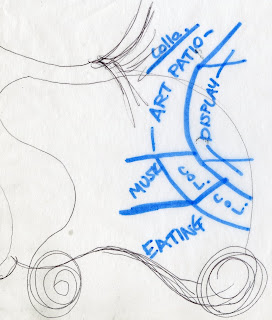
The Tree is a structure that matures to the shape you want it too. The limbs would act as a shade for the art courtyard. The purple line on the ground is a representation of a datum line, which is poured concrete. The objects on the datum line are music interactive walls and textile interactive walls. In the back of the courtyard are the interactive walls for the art students. These interactive walls we decided to keep in our final design, with a few changes to the system.
This is a view of tree system with out the datum lines. The awning above of the courtyard was our original idea about covering the courtyard area. However, we decided not to keep this idea and keep the courtyard area open for natural daylight to get in.

Again, this is the tree system. The product on the left is a textile product, which would allow for people to braid the fabrics or allow the wind to blow the fabric around. The green object on the right is a grass seat. The curved lines on the ceiling is the aqueduct, which leads to a water wheel in the back of the courtyard.

































